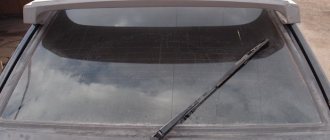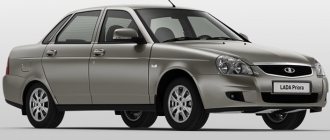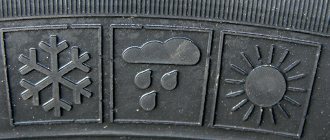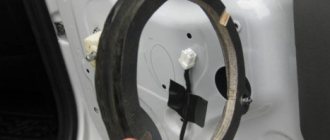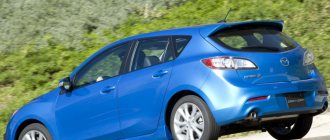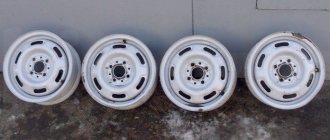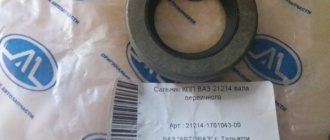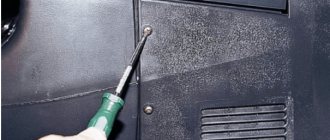Factory dimensions
All linear dimensions of the VAZ 2110 body can be found by looking through the instruction book or rummaging around on the Internet.
But the main dimensions are:
- if we take the end points of the front and rear bumpers, then here we have 4265 mm;
- length between the centers of the front and rear wheels, the so-called. wheelbase is 2492 mm;
- from the center of the front wheel to the extreme point of the front bumper - 829 mm;
- from the center of the rear wheel to the end point of the rear bumper - 944 mm.
The height of VAZ 2110 is 1420 mm.
- in front at the extreme points of the “factory” mirrors – 1875;
- front excluding mirrors (purely hardware) – 1680 mm;
- distance between the centers of the front wheels – 1400 mm;
- the rear of the car has a width between wheel centers of 1370 mm.
Features of car recycling
Before you scrap your car, you should familiarize yourself with the principles of this procedure. The average weight of a vehicle is 1000 kg. If the entire car can be recycled, the collection point will deduct 30% for clogging. The latter includes all non-metallic elements, pollution, etc.
Let's consider how much a car for scrap metal weighs using the example of a VAZ 2105. The weight of the latter is 955 kg. Thus, taking away the blockage, we get about 660 kg. You should also take into account the price of scrap, which differs depending on the city. As a rule, in megacities, the number of rubles received for a car will significantly exceed the amount earned in a similar organization in a small locality.
Before calculating the profit from a scrapped car, you need to take into account transportation costs. If the car is a pile of metal, you need to take care of a tow truck. If there are spinning wheels and functional steering, the car can be transported in tow. Then, this expense item will not be so significant. Therefore, in order to calculate how much a Zhiguli costs when scrapped, it is not enough to know how much a VAZ 2109 or 21099 weighs for scrap metal (915 kg). It is necessary to take into account the features of recycling and the requirements of collection points. It would be useful to know the average cost of scrap metal in the region. Additional awareness will allow you to avoid fraud on the part of unscrupulous receivers.
Despite the fact that disassembling a car is a labor-intensive procedure, many owners still decide to take this step. Thus, you can sort ferrous and non-ferrous metals and hand them over separately, removing the good parts. From an economic point of view, the procedure will be justified.
Let's consider how much a VAZ 2106 weighs for scrap metal based on individual significant structural elements:
It should be noted that dismantling machine parts requires a lot of time and certain skills. In the absence of the latter, it would be more rational to recycle it entirely.
I took the car for spare parts, I took off everything I could, I wanted to sell it as metal, but there are no scales to weigh the body. If anyone knows, tell me how much the bare body of a VAZ 2110 weighs (without doors, trunk lid, hood, rear and front beams, A-pillars, and fenders) in advance thanks a lot!
Comments 16
330 kg turned out
I also sold it without a roof for 2k, with the price of metal being 6.5r/kg
everywhere? Some of us also have 5. There are also 7, but there the scales are twisted too much))
yes, if you take the current to the city
at a price of 7-8 rubles per kg they give about 2-2.3 k for a bare body. cut into pieces. This makes it easier to transport and weigh
Read more: DRL for Chevrolet Cruze
If the body is alive, they can buy a quarter or anyone who needs anything (left glass, roof, rear part), and this is more expensive than scrap metal
It’s a long time and he’s bothering me...
they seem to cost more in pieces)
from a penny entirely without doors and hood - pulled 330 kg, from 10 I don’t know
They accept bodies, don’t listen to anyone, you’ll just have to look where. I personally went there to hand over the metal - there was a gantry crane and scales on a hook, and workers there cut the bodies with a cutter and loaded them into the wagons right away. In small caricatures this may not be accepted, but in general they may require some kind of paper, a passport 100%. I didn’t hand over the body itself, a friend had been carrying a penny for a long time, he didn’t even ask about the weight.
| Model | Curb weight, kg | Permitted maximum weight, kg |
| VAZ-2101 | 955 | 1355 |
| VAZ-2102 | 1010 | 1440 |
| VAZ-2103 | 955 | 1355 |
| VAZ-2104 | 1020 | 1475 |
| VAZ-2105 | 995 | 1395 |
| VAZ-2106 | 1045 | 1445 |
| VAZ-2107 | 1030 | 1430 |
| VAZ-2108 | 900 | 1325 |
| VAZ-2109 | 945 | 1370 |
| VAZ-21099 | 970 | 1395 |
| VAZ-21011 | 955 | 1355 |
| VAZ-2110 | 1010 | 1485 |
| VAZ-21102 | 1020 | 1495 |
| VAZ-21103 | 1040 | 1515 |
| VAZ-2111 | 1040 | 1540 |
| VAZ-21111 | 1030 | 1530 |
| VAZ-21113 | 1060 | 1560 |
| VAZ-2112 | 1040 | 1515 |
| VAZ-21122 | 1020 | 1495 |
| VAZ-2113 | 975 | 1400 |
| VAZ-2114 | 970 | 1395 |
| VAZ-2115 | 985 | 1410 |
| VAZ-2121 | 1210 | 1610 |
| VAZ-2170 Lada Priora | 1088 | 1578 |
| VAZ-2170 Lada Priora station wagon | 1088 | 1593 |
| VAZ-1118 Lada Kalina | 1070 | 1545 |
The curb weight of a vehicle is the weight of a vehicle with standard equipment, various consumables (oil, coolant, etc.), but minus the weight of passengers, driver and luggage.
Dry weight is equal to curb weight, but only without fuel, some equipment and consumables. That is, this is the mass of an unloaded vehicle without fuel.
The permissible gross weight is the weight of the maximum loaded vehicle provided by the manufacturer. This is sometimes called the maximum permissible mass. It is better not to go beyond the limits of this indicator, unless, of course, you want your car to last for a very long time. The increased load has a negative impact on the car body and suspension parts.
Random entries - how much does it weigh:
Domestic cars are always popular among car owners. The main reason is availability in terms of price, as well as inexpensive maintenance. Back in Soviet times, VAZ earned a reputation as a high-quality and reliable car.
True, over time, drivers began to trust VAZ cars less, but this does not apply to older models like 2112 and those that came before it. The VAZ-2112 car began to be produced in the late 90s. And he still enjoys trust.
Instrumental check by checkpoints
And yet, things are not always so simple. And even an experienced eye will not always notice small “inconsistencies”. With proper body repair, the geometric dimensions can only be checked by taking measurements. Professionals use special meters for this.
But to carry out this procedure at home, an ordinary tape measure is sufficient. You need to find special control marks that are located on the bottom of the VAZ body. It is from them that measurements should be taken. How and in what sequence can be found in the operating instructions for the VAZ 2110.
Check points on the body and underbody
It is necessary to take measurements at the following points:
- Diagonal. Before measuring body dimensions using reference points, you can take just two measurements that will help clarify the picture. Drive the car onto an overpass or pit and use a tape measure from below to measure the dimensions diagonally. They must match, as they say, neck to neck. Match up? Great, but don't stop there;
- Racks. You definitely need to check the racks. First - from the unbeaten side (if such is known), then - from the bat. In principle, in this case you can choose any body points (the main thing is that they are the same on both sides). For example, from the pillar to the edge of the bend on the rear doors. Also on the front ones. The sizes match - great. Let's move on;
- Roof. To make sure that the roof of the VAZ 2110 does not “sink”, you need to measure the dimensions of the door diagonals - from the lower rear corner diagonally to the upper front corner. Naturally, the dimensions on both sides should be the same. In addition to this, it is advisable to measure the diagonals of the roof itself;
- Windshield. For some reason, many people believe that if the windshield “fits” normally, then control measurements are not needed, they say, the geometric dimensions of the body are in order. This is mistake. You need to measure - moreover, diagonally, and choosing points at the same distance on both sides.
Subtleties of body repair
Body repairs are most often carried out after an accident, but also if some parts are rusty. But you should still try to avoid welding and other work that involves thermal heating of the metal.
If possible, try not to remove bezels. This can also lead to changes in body geometry. And after any repair work related to the body, be sure to check its linear dimensions.
Small class cars
VAZ-2110
(export name
LADA
110) with a four-door five-seater sedan body (class C according to the international classification) are equipped with injection engines with a displacement of 1.6 liters: eight-valve mod.
VAZ-21114 with a power of 80.2 hp. and sixteen-arm mod. VAZ-21124 with a power of 89.1 hp. The engines are located across the engine compartment, equipped with a three-component exhaust gas catalyst with feedback and meet Euro-2 and Euro-3 standards. Previously, cars were equipped with engines with a displacement of 1.5 liters: first carburetor and then injection. Rice. 1.1. Overall dimensions
VAZ-2110
car The body is load-bearing, all-metal, of welded construction with hinged doors, front fenders, hood and trunk lid.
A hatch that opens from the trunk leading into the cabin allows you to transport long items. Part of the production of modification 21103 with a 16-valve VAZ-2112 engine is equipped with air conditioning, and since the end of 2002, on request, with power steering from ZF. This modification differs from the basic one by a hood with an integrated radiator lining of a more modern shape and a front bumper, as well as original headlights. The rear lights, moldings and interior details have also been changed. In 1998, production of the VAZ
-2111 car (export name
LADA
111) with a station wagon body began.
According to the layout, engine, transmission, chassis, body equipment, this car is identical to the VAZ-2110 car. It differs only in a modified rear end with a large tailgate. The trunk of this car is the most spacious in the family: 490 liters with the rear row of seats raised and 1420 liters with them folded. VAZ
car (export name
LADA
112) with a hatchback body began in 2000. The layout of this car is the same as that of the VAZ-2111, but the body has a large rear angle. This car model uses only injection engines: both 8-valve and 16-valve. The rear seat folds in a 2:3 ratio, which allows you to increase luggage capacity from 415 to 1270 liters.
Rice. 1.2. Overall dimensions of the VAZ-2111 car The salon, like other models of the family, is equipped in “standard”, “norm” and “luxury” trim levels. The latest equipment includes fog lights, headlight cleaner and washer, 14-inch alloy wheels, three-way catalytic converter (Euro-2), internal sound-insulating hood trim, door safety bars, immobilizer, on-board monitoring system, seat upholstery made of velvet and soft door upholstery, central electric door locking, electric windows. By additional order, an on-board computer, electric front seat heaters, electric outside rear-view mirrors, anti-lock brakes, an airbag and a sunroof are installed.
Rice. 1.3. Overall dimensions of the VAZ-2112 car
| Like | Tweet |
Your reviews, comments, questions and answers to the site
Everyone is welcome to participate in the discussion about the causes of the malfunction and other problems. If you know what to answer, write and thereby help other VAZ 2110 owners in searching for the truth.
To independently solve the problem of restoring parts of a VAZ 2112 car, you need to have the geometric dimensions of its body. In professional workshops, these parameters must be taken into account, and they are individual for each machine model. Violation of body geometry must be eliminated, since it significantly reduces the safety of driving such a car. From this article you can learn important information about the indicators on which high-quality repair of the VAZ 2112 body depends.
see also
Comments 16
330 kg turned out
I also sold it without a roof for 2k, with the price of metal being 6.5r/kg
everywhere? Some of us also have 5. There are also 7, but there the scales are twisted too much))
yes, if you take the current to the city
at a price of 7-8 rubles per kg they give about 2-2.3 k for a bare body. cut into pieces. This makes it easier to transport and weigh
If the body is alive, they can buy a quarter or anyone who needs anything (left glass, roof, rear part), and this is more expensive than scrap metal
It’s a long time and he’s bothering me...
they seem to cost more in pieces)
from a penny entirely without doors and hood - pulled 330 kg, from 10 I don’t know
They accept bodies, don’t listen to anyone, you’ll just have to look where. I personally went there to hand over the metal - there was a gantry crane and scales on a hook, and workers there cut the bodies with a cutter and loaded them into the wagons right away. In small caricatures this may not be accepted, but in general they may require some kind of paper, a passport 100%. I didn’t hand over the body itself, a friend had been carrying a penny for a long time, he didn’t even ask about the weight.
Firstly, they won’t accept a whole body for scrap metal, they even take it in pieces with reluctance. And secondly, where metal is accepted, there should be scales that weigh the truck with metal on board at the entrance and without metal at the exit, and they pay the difference, and who even needed your weighing?
They are unlikely to accept it whole; they will have to cut it anyway. So you can do this and weigh it on a relatively small scale. I disassemble cars myself, I give advice) It is necessary to at least dismember them into 4 parts. two large circles for a grinder should be enough
Thank you, but here at our house they accept small Soviet scales, I’m from the region 100 km from Ryazan
The most common vehicles in the post-Soviet space have always been considered to be the products of the Volga automobile industry. These cars faithfully served their owners for decades. Therefore, the question of how much a VAZ 2107 weighs for scrap metal does not surprise anyone. The same applies to other car models that are subject to recycling.
The Lada Seven, according to documents, has a mass of 1049 kg. However, its weight is practically no different from any other brand of car from the Volzhsky Automobile Plant. The average weight of this Soviet car, which is often scrapped, is around one ton.
Sometimes owners of relatively new cars have to go to a metal collection point. The vehicle may be damaged as a result of an accident or other accident. In some situations, from an economic point of view, the only right decision would be to scrap the car.
Read more: Replacing the fuel filter Santa Fe classic
Sometimes drivers prefer to disassemble the car themselves. Therefore, the relevance of the question of how much a VAZ 2101 body weighs for scrap metal is understandable. Considering that Kopeyka is the oldest representative of this line of the domestic automobile industry, it is the leader among cars that can be recycled. Its scrap weight is 955 kg, of which the body takes up about 280.
The influence of body geometry on handling
During the operation of a VAZ 2112 car, sooner or later deformation of body parts occurs. Safety on the road and ease of operation depend on the level of their wear.
VAZ 2112 has been produced since 1999. The car body of this model is similar to the 2110 modification, the difference is that the first is slightly shorter than the second.
The body length of the 2112 is 4170 mm, the luggage compartment volume is 400 liters. Thanks to these changes, the unit is easier to control compared to the tenth model.
The steering wheel makes turns easier and faster.
Model 2112 is characterized by a sporty character. It combines the winning parts of the 10 with the estate rear seat from the 2111, making the car much roomier and more maneuverable. The ability to transform the rear seat allows, if necessary, to significantly increase the volume of the interior. Improved handling characteristics have simplified the process of entering a turn, which has significantly increased the level of safety for road users.
The VAZ 2112 has several modifications, for example, model 21123 is characterized by an original design of the hood and bumper, which allowed the car body to become popular among many car enthusiasts. After some time, the VAZ 2112 had a new grille model, and the hood took on a standard look.
External description of the VAZ-2112
This brand of car differs from its previous brothers in both external and internal parameters. The body of the car has been improved, it has become slightly longer, due to this the volume of the luggage compartment has increased to 400 liters. And if you fold down the rear seats, you can carry more cargo.
It is especially worth noting the convenience of splitting the rear seat, which allows you to transport small loads while maintaining the comfort of the car. Add to this a more sporty handling. The brand has retained the advantages of its predecessors with minor innovations depending on the configuration.
Thus, the most budget option was considered to be the 21122 package, where the engine from 2111 was installed, with non-ventilated brakes from 2108 and without electric windows.
The elite version was 21128 with an engine capacity of 1.8 and a power of 100 horses. The production of the popular brand VAZ-2112 lasted from 1999 to 2008 in small batches, this made it possible to maintain stable demand for this car.
Read more: Ural wheel size 4320
Geometric dimensions of the “two-piece”
VAZ 2112 is one of the most popular models among the cars produced by the domestic automotive industry. It is relatively inexpensive, has a good design and different body styles.
The main geometric dimensions of the body of this car are as follows (in mm):
- length – 4170;
- width without mirrors – 1680;
- height – 1435;
- width with mirrors – 1875;
- rear door opening diagonal – 1320;
- short diagonal of the rear side window frame – 230;
- the distance between the center of the upper beam of the rear door opening to the middle of its lower beam is 1050;
- the long diagonal of the rear side window frame is 710.
The rarest body type of the 2112 is a coupe, or three-door hatchback. This is a sports model, it stands out from others, which are monotonous in terms of the geometric dimensions of the body. It was the design features of the VAZ 2112 coupe that allowed the model to become in demand at one time. However, after ten thousand examples of the 2112 coupe were produced, production ceased, so it is considered a rare model.
Several modifications of the VAZ 2112 were equipped with hatches, which greatly increased the comfort of the driver and passengers on the road. The geometric dimensions of 2112 made it possible to equip the car with many additional functional capabilities.
Specifications
During the production of the 2110 model, the Volzhsky plant created more than a dozen different modifications of this sedan, including the Consul limousine with a greatly increased wheelbase. However, most of the cars were produced in the following modifications:
Technical characteristics of model 2110-010:
- curb weight - 1010 kg;
- maximum weight of passengers and luggage - 470 kg;
- engine brand - 2110;
- power type - carburetor;
- volume - 1.5 liters;
- power - 72 hp;
- acceleration to 100 - 14 s;
- highest speed - 165 km/h;
- average gasoline consumption in the combined cycle is 6.6 liters.
Technical characteristics of model 21102:
- curb weight - 1020 kg;
- maximum weight of passengers and luggage - 460 kg;
- engine brand - 2111;
- volume - 1.5 liters;
- power - 76 hp;
- acceleration to 100 - 14 s;
- highest speed - 170 km/h;
- average gasoline consumption in the combined cycle is 7.1 liters.
Technical characteristics of model 21103:
- curb weight - 1060 kg;
- maximum weight of passengers and luggage - 455 kg;
- engine brand - 2112;
- power type - distributed injection;
- volume - 1.5 liters;
- power - 93.5 hp;
- acceleration to 100 - 12.5 s;
- highest speed - 185 km/h;
- average gasoline consumption in the combined cycle is 7.2 liters.
Overall dimensions of VAZ-2110 cars, 2111, 2112
VAZ-2110 is a front-wheel drive passenger car with a transverse power unit, designed for use on paved roads.
The body is all-metal, monocoque, four-door, sedan type. To transport large and long cargo, the rear seat can be folded, thereby increasing the trunk volume.
Engines are four-cylinder, carburetor or with various fuel injection systems, with a displacement of 1.5 liters. Thanks to the front-wheel drive layout, the car has improved handling characteristics compared to rear-wheel drive VAZ models, especially on slippery roads and when cornering.
It is possible to equip the car with fog lights, heated front seats, electric windows, an on-board computer, a catalytic converter in the exhaust system, electric exterior mirrors, an electronic anti-theft system, air conditioning, anti-lock brakes, an airbag, and a sunroof.
Body parts most susceptible to deformation
Sharp braking or untimely start provoke, first of all, damage to the bumper. If it is insignificant, then during repairs it is possible to achieve the performance of standard geometry. In the presence of complex deformations, this cannot be done, so it is easier to replace the damaged body part with a new one.
If the owner of the car does not take enough care of the condition of the body, then those parts that have close contact with the road surface are quickly eaten away by corrosion. And repairing the hood, doors and hidden body parts instead of timely prevention is already more difficult and expensive.
They may be violated if the car has been in an accident. A car accident may involve the crash of two vehicles colliding together, a collision with an obstacle, or a wheel falling into a hole. From the article you will learn how to measure the geometry of a “ten” body, what methods allow you to give an accurate conclusion about deformations and damage, and much more.
Body geometry and its diagnostics
The most important components of body geometry are called control points. It is the knowledge of their location and the ability to correctly measure the distances between them that determines the structure of checking the body for deformation. You can learn more about control points from the technical documentation for each car model.
After identifying damage, the integrity of the body is usually restored in special workshops. Experienced straighteners bring the body back to normal in the shortest possible time, if only the deformations are of moderate or minor severity. A body that has been in a serious accident and has received a lot of deformation is usually easier to replace with a new one.
What deformations can occur on the VAZ 2110?
The “Ten” involved in the accident will have certain deviations from the standard positions marked at the factory. And destruction in this case means the following:
- Deviations in terms of the standard wheel arrangement, as evidenced by poor vehicle stability and increased tire wear;
- The diagonals, again, standardly installed at the factory, are violated. Doorways, pillars and other areas of the body, one way or another, associated with the impact zone are especially often affected.
In most cases, the destruction of functional elements is associated with the appearance of folds in the floor or other components of the body. In addition, external impacts cause a significant increase in the part in areas far from the point of impact.
Note. Such structurally weak areas include empty spaces between welds, side members and other elements where free mutual movement of metal sheets is observed.
Several ways to check the body for deformation
You can determine the deformation of a body that has been in a moderate accident at first glance. On the contrary, if the blow was weak, then it can be extremely difficult to determine the damage by eye. In this case, you have to carefully carry out diagnostics, measure compliance, and so on.
A hydraulic jack helps to carry out an initial inspection of the car. Thanks to the lift, you can examine the condition of the floor, feel those parts of the body that are inaccessible for inspection with the normal position of the car, for the presence of folds. After detecting the latter, as a rule, they are marked with a marker, which makes it possible to easily find deformed areas during subsequent stages of work.
If such a check does not give any results, proceed to the next stage of the examination, which involves checking the wheels. It is no longer a jack, but a special stand that helps carry out the check. Using such equipment, it is easy and faster to carry out the second stage of diagnostics. Check the front and rear wheels of the car at control points using calipers with a special profile shape.
Checking the compliance of the control points of the “shoes” of the car involves verification (comparing) the wheel coordinates located on one side of the car with the coordinates on the other side. Body deformation becomes obvious if measurements show significant deviations from specified standards.
Another method of diagnosing damage to the “tens” body is to compare the diagonals. The exact coordinates of the main diagonals are given in the table below. This diagnosis is considered the most correct, since it is carried out using a symmetry check.
Modern technologies allow this to be done using various tools. A computer on which appropriate measurements are carried out helps a lot in this matter. The option of checking using template tools and mechanical measurements is also used.
As a rule, at home on a VAZ 2110 you can remove the geometric dimensions of the body yourself using a standard tape measure. But at the service station, a special telescopic ruler is already used for the same purpose, which gives more accurate results.
But both of these measurement methods have a significant drawback. Thus, they do not make it possible to measure spatial deformations. The latter can only be diagnosed using template or computer methods. This will give a complete picture of the deformations, which will allow the damage to be eliminated most effectively. Although, the price of such a check will be many times higher.
The car body is an intricate and complex structure that has a number of values required for normal operation. Their violation causes significant deviations, the configuration of the entire body changes. By measuring the geometry of the body, the car owner has the opportunity to detect even the most minor defects, which can lead to big problems in the future.
Factory body dimensions of the VAZ 2110
| Length | if we take the end points of the front and rear bumpers, then here we have 4265 mm; length between the centers of the front and rear wheels, the so-called. wheelbase is 2492 mm; from the center of the front wheel to the extreme point of the front bumper - 829 mm; from the center of the rear wheel to the end point of the rear bumper - 944 mm |
| Height | 1420 mm |
| Width | in front at the extreme points of the “factory” mirrors – 1875; front excluding mirrors (purely hardware) – 1680 mm; distance between the centers of the front wheels – 1400 mm; the rear of the car has a width between wheel centers of 1370 mm |
dimensions
As noted above, the 2110 sedan turned out to be wider, taller, longer and heavier than the cars of the base family. This happened thanks to the desire of the designers of the Volzhsky Automobile Plant to increase the space in the car interior and increase comfort for the driver and passengers.
Thanks to the increase in the wheelbase and the width of the body, the car has become much more spacious; the semi-recumbent driver's seat, so characteristic of the Lada Samara family, has become a thing of the past; there is more space for passengers sitting in the back. The 110 family became the mother family for the premium Priora model. Overall dimensions of VAZ 2110:
- body length (including bumpers) - 426.5 cm;
- wheelbase length - 249.2 cm;
- height when equipped - 142 cm;
- distance from the front axle to the end of the bumper - 829 mm;
- distance from the rear axle to the end of the bumper - 944 mm;
- body width - 168 cm;
- the distance between the tips of the side mirrors is 187.5 cm;
- front track - 140 cm;
- rear track - 137 cm;
- maximum ground clearance (empty car) - 18 cm;
- ground clearance (unloaded car and driver) - 17 cm;
- minimum ground clearance (driver, 4 passengers and luggage) - 16.5 cm.
It is worth noting that ground clearance is based on 13-inch wheels with 175/70 tires, or 14-inch wheels with 175/65 tires. When using other wheels or tires, the ground clearance will be different.
Dimensions of the diagonals of the VAZ 2110 body
| Diagonal of the front door opening from the extreme point of the threshold from below to the top of the pillar (long diagonal), mm | 1345 |
| Diagonal of the front door opening from the extreme point of the bottom of the front window to the bottom of the door pillar (short diagonal), mm | 900 |
| Diagonal of the rear door opening from the extreme point of the threshold from the bottom to the top of the pillar (long diagonal), mm | 1040 |
| Diagonal of the front door opening from the extreme point of the bottom of the rear window to the bottom of the door pillar (short diagonal), mm | 1050 |
| Hood diagonal, mm | 1490 |
| Trunk lid diagonal, mm | 1090 |
| Front window diagonal, mm | 1365 |
| Rear window diagonal, mm | 1215 |
Several recovery methods
The “tens” body, in most cases, includes 6 types of work in the following order:
- Diagnostics of the body, checking it for deformations and their nature, severity, and so on;
- Work aimed at eliminating surface damage. They are also called tin works;
- Straightening and pulling of deformed parts, including the presence of special equipment such as a slipway;
- Removal of excessively damaged components of the body and its attached parts;
- Replacement of body parts with original elements;
- Painting and paint restoration.
In this video you can see how a body part is pulled out using a slipway.
